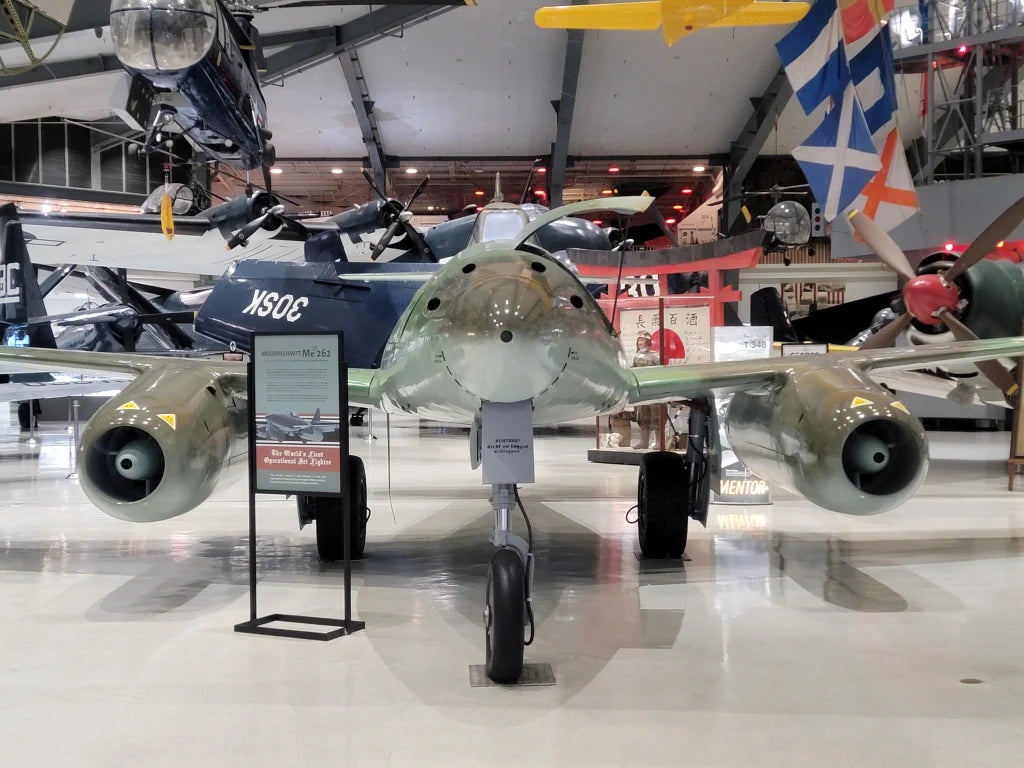Discussions about World War II aviation often pit legendary aircraft against one another in debates about their superiority. In such conversations, two iconic planes invariably take center stage: the German Me 262, the first operational jet-powered fighter aircraft, and the American P-51 Mustang, an epitome of piston-engine performance. So, which was the better aircraft? It’s a question that invites intricate debate, spanning aerodynamics, engine technology, and even pilot training.
A Brief Introduction
The Me 262, christened “Schwalbe” (Swallow), was a marvel of German engineering. You know, it’s fascinating when you look at the specs. The Me 262 was like a rocket with wings, hitting insane speeds over 500 mph, blowing past anything the Allies threw up in the sky. But then you’ve got the P-51 Mustang—she was a beauty. The later versions, with the smooth lines and that beastly Rolls-Royce Merlin engine weren’t just for show. That Mustang was in it for the long haul, escorting bombers and giving the Luftwaffe pilots nightmares.
Performance & Capabilities
The Me 262’s revolutionary jet engines gave it a tremendous speed advantage, allowing it to engage or disengage from combat at will. Its four 30mm MK 108 cannons were devastating against bombers, and in the hands of an experienced pilot, it could be a lethal adversary.
However, the Me 262 had its Achilles’ heel. Its engines, pioneering as they were, had a short operational life and were prone to malfunctions. Additionally, the turbojet technology of the time resulted in sluggish throttle response, leaving the aircraft vulnerable during throttle changes.
The P-51, while slower, was extremely agile at high altitudes. Its laminar flow wing design reduced drag and allowed for excellent energy retention. Combined with skilled pilots who used the Mustang’s strengths to their advantage, the P-51 could counter the Me 262’s speed with superior maneuverability.
Operational Context
When assessing aircraft, it’s not enough to merely evaluate the technology. The operational context has to be kept in mind. By the time the Me 262 became operational in 1944, the Allies had already achieved air supremacy. The Me 262s were often grounded due to lack of fuel or were ambushed upon takeoff or landing by prowling Allied fighters, particularly the P-51s.
Furthermore, while the Me 262 pilots were trained in jet combat, the rushed nature of their training program meant they weren’t always equipped with the necessary tactics to face the seasoned P-51 pilots, many of whom had dozens of sorties under their belts.
Concluding Thoughts
From a purely technological perspective, the Me 262 showcased the future of aerial combat, heralding the jet age. Its speed and firepower were unrivaled. But technology alone doesn’t determine the outcome of aerial duels. Pilot training, tactics, logistical support, and the strategic context all play decisive roles.
However, when you think about the closing chapters of World War II, the P-51 Mustang stole the show over Europe. Flying high and far, with some ace pilots in the cockpit, it had the skies pretty much on lockdown. But then there’s the Me 262—super high-tech for its time but missed its moment. The Germans rolled it out too late, and there weren’t enough Me 262s to change how the air battles went.
So, was the Me 262 better than the P-51? The Me 262 was like a glimpse into the future on the tech front. But when you zoom in on the World War II timeline, the P-51 was king of the skies. Still, both planes can be commended —they’re shining examples of what could be dreamed of and built.
For more insights into the Me 262 and other important military aircraft, visit Aces In Action. Here, you’ll find a fantastic piece of artwork by Craig Tinder titled “Untouchable Pursuit” which illustrates the Luftwaffe Pilot Hans Mutke in a fleeing attempt to escape USAAF P-51D Mustangs. The limited edition canvas print even includes a piece of 4-meter aluminum sheets from an Me 262 production line that a fleeing Czech worker removed when German production ceased at the war’s end, making it a unique piece of history!
Untouchable Pursuit – Me 262 Aviation Art Print by Artist Craig Tinder
25 April 1945 – In an untouchable pursuit by the U.S. 8th Air Force P-51D Mustangs, Ens. Hans Guido Mutke accelerates “White 3”, his trusted Me-262 to safety. Mutke would later claim that he was the first to break the sound barrier – in the Me-262.
To purchase or see similar items, visit here.
Commissioned by Museums, Treasured by Collectors





Share:
Did an F4U Corsair Shoot Down a MiG-15?
The Intriguing Disparity: Doodlebugs and V-2 Rockets